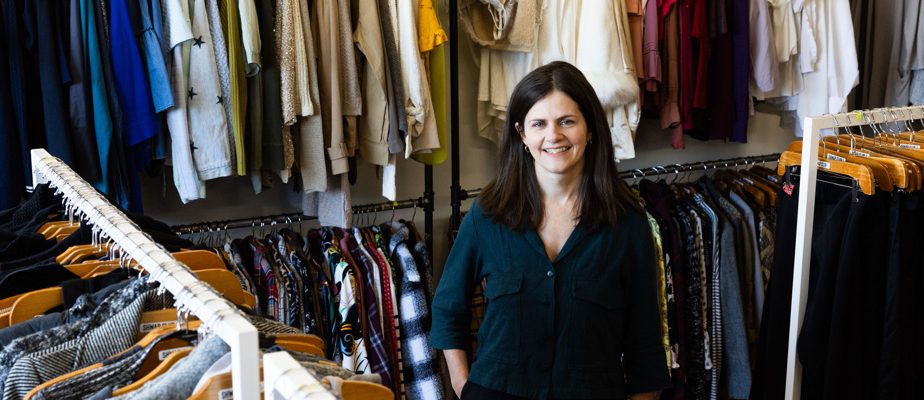After the challenge, then the report, here is now the book. These days, colleague Valérie Simard has signed an unclassifiable work, halfway between a soap opera and an investigation, oscillating between fieldwork, reflection and analysis, on a very particular year of detox: her clothing detox.
Let’s make things clear right away: no, this is not a frivolous subject, nor is the point moralizing. Quite the opposite: just read the first pages of this Year of clothing detox, thoughts on ready-to-throw itemspublished by Éditions La Presse, to be sure.
From the first lines, the journalist recounts the extent to which the collapse of Rana Plaza in Bangladesh, then the brutal death of a thousand people, a symbol if need be of the excesses of the fast fashion, upset her. Not to mention the images of the Atacama Desert in Chile, transformed into a veritable cemetery of used clothing. She could no longer consume clothes as she did, turning a blind eye to the human, social and environmental impacts. She had to do something.
Thus was born, in summary, his famous challenge, launched on 1er April 2022, finished in April 2023, right on Earth Day: a year of clothing detox. We make the subject more frivolous, we understand.
“And I really don’t want people to feel guilty,” continues the journalist, met at her home last month to discuss it. That’s not how you bring about change. We are all victims of the system, of advertising, of the way fashion trends are pushed onto us. »

PHOTO MARTIN TREMBLAY, THE PRESS
Valérie Simard
I wanted people to understand the forces that push us to consume and have this constant need to renew our wardrobe.
Valérie Simard, journalist and author
Perhaps you have read the report on her challenge, “a year without new clothes”, launched to her and her son last year (“my boyfriend is in a year without shopping perpetual,” she said, laughing).
The book, in bookstores towards the end of the week, goes even further. Or deeper, let’s say. “I had a thought that I was not able to share in this report: the psychological aspect,” she continues. Now, for me, this is the heart of the subject: why do we consume? Why do I have this desire? I’m not a fashionista either, I’m an average consumer, but why do I have this occasional desire to shop and get new linen? »
She did the math: in 2019, just before the pandemic, Valérie Simard spent $2,000 on new clothes for herself and her son, a figure below the Canadian average (around $3,300 per household). In total, there are more than 200 pieces piled up in her closet, sweaters here, pants there, and further down “the dresses that I never wear,” she says with a laugh, showing us her stock of clothes, barely half of which she wore during her famous year of “clothing fast”. This means if we consume too much. Wrong. Repeat.
Looking for solutions
Over the course of the chapters, Valérie Simard recounts her “withdrawal” (she took up knitting to compensate for her need for something “new”!), relates her meetings with women who had the experience like her (yes, yes, you ask yourself the question, the figures confirm it: it is indeed a primarily female problem), and above all in search of solutions.
These solutions, it should be noted, are never unilateral, always nuanced, complex as desired. The premises, the rental, the used? Which subject to prioritize? “It’s not clear, actually! » One example among a thousand? Thrift stores. “I didn’t expect that I would reproduce my over-consumption behaviors,” illustrates Valérie Simard. Hence several questions raised here: is second hand necessarily better? What if this market fueled the new home market?
Funny detail, in the end, Valérie Simard could not escape it: she remained stuck with her unloved ones skinny jeans. “Yes,” she giggles. But why do I want wider jeans? she especially asked herself. Is it just a question of social pressure and fashion? […] I forced myself to free myself from all that. » That gives you an idea of the subject, oscillating between personal confidences and reflections, or outright questioning.
What to remember? “The perfect garment does not exist,” summarizes the author, who also found herself almost “paralyzed” at the end of her challenge, not knowing where to go or what to dare to buy. She finally opted for a black linen blouse, from the local brand Atelier B. “Linen is one of the most eco-responsible natural materials,” she points out. At the same time, black is the most environmentally harmful dye. But at some point, she says, you have to buy something that will last and that you will wear…” If there is only one thing to remember, it is this.

A year of clothing detox, thoughts on ready-to-throw items
Editions La Presse
167 pages
